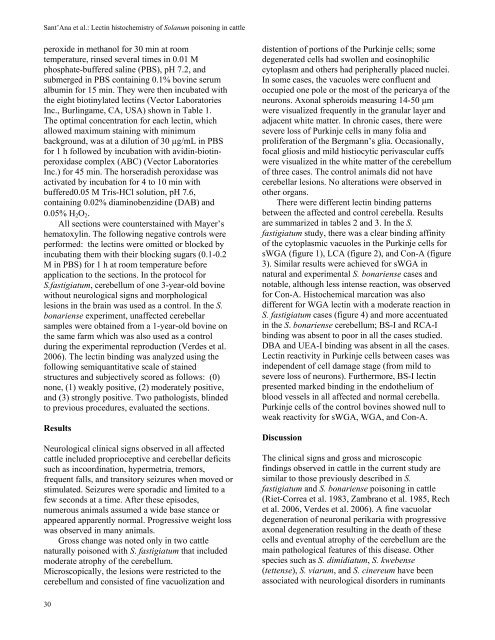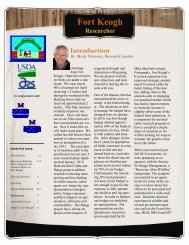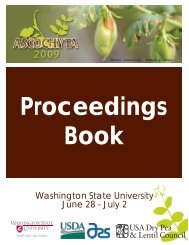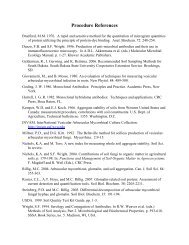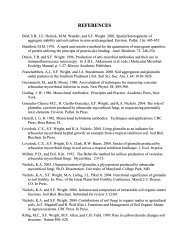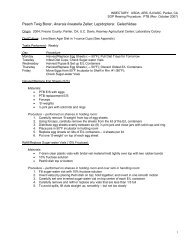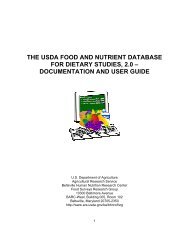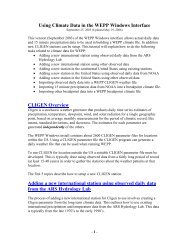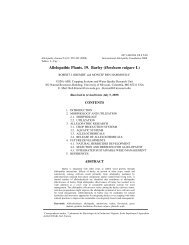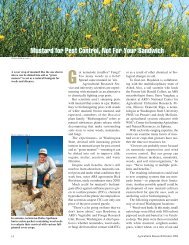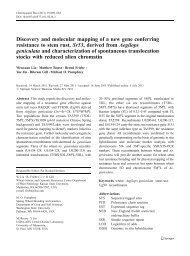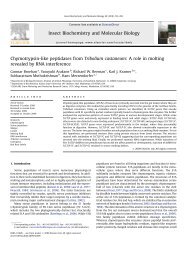International Journal of Poisonous Plant Research - Agricultural ...
International Journal of Poisonous Plant Research - Agricultural ...
International Journal of Poisonous Plant Research - Agricultural ...
Create successful ePaper yourself
Turn your PDF publications into a flip-book with our unique Google optimized e-Paper software.
Sant’Ana et al.: Lectin histochemistry <strong>of</strong> Solanum poisoning in cattle<br />
peroxide in methanol for 30 min at room<br />
temperature, rinsed several times in 0.01 M<br />
phosphate-buffered saline (PBS), pH 7.2, and<br />
submerged in PBS containing 0.1% bovine serum<br />
albumin for 15 min. They were then incubated with<br />
the eight biotinylated lectins (Vector Laboratories<br />
Inc., Burlingame, CA, USA) shown in Table 1.<br />
The optimal concentration for each lectin, which<br />
allowed maximum staining with minimum<br />
background, was at a dilution <strong>of</strong> 30 µg/mL in PBS<br />
for 1 h followed by incubation with avidin-biotinperoxidase<br />
complex (ABC) (Vector Laboratories<br />
Inc.) for 45 min. The horseradish peroxidase was<br />
activated by incubation for 4 to 10 min with<br />
buffered0.05 M Tris-HCl solution, pH 7.6,<br />
containing 0.02% diaminobenzidine (DAB) and<br />
0.05% H2O2.<br />
All sections were counterstained with Mayer’s<br />
hematoxylin. The following negative controls were<br />
performed: the lectins were omitted or blocked by<br />
incubating them with their blocking sugars (0.1-0.2<br />
M in PBS) for 1 h at room temperature before<br />
application to the sections. In the protocol for<br />
S.fastigiatum, cerebellum <strong>of</strong> one 3-year-old bovine<br />
without neurological signs and morphological<br />
lesions in the brain was used as a control. In the S.<br />
bonariense experiment, unaffected cerebellar<br />
samples were obtained from a 1-year-old bovine on<br />
the same farm which was also used as a control<br />
during the experimental reproduction (Verdes et al.<br />
2006). The lectin binding was analyzed using the<br />
following semiquantitative scale <strong>of</strong> stained<br />
structures and subjectively scored as follows: (0)<br />
none, (1) weakly positive, (2) moderately positive,<br />
and (3) strongly positive. Two pathologists, blinded<br />
to previous procedures, evaluated the sections.<br />
Results<br />
Neurological clinical signs observed in all affected<br />
cattle included proprioceptive and cerebellar deficits<br />
such as incoordination, hypermetria, tremors,<br />
frequent falls, and transitory seizures when moved or<br />
stimulated. Seizures were sporadic and limited to a<br />
few seconds at a time. After these episodes,<br />
numerous animals assumed a wide base stance or<br />
appeared apparently normal. Progressive weight loss<br />
was observed in many animals.<br />
Gross change was noted only in two cattle<br />
naturally poisoned with S. fastigiatum that included<br />
moderate atrophy <strong>of</strong> the cerebellum.<br />
Microscopically, the lesions were restricted to the<br />
cerebellum and consisted <strong>of</strong> fine vacuolization and<br />
30<br />
distention <strong>of</strong> portions <strong>of</strong> the Purkinje cells; some<br />
degenerated cells had swollen and eosinophilic<br />
cytoplasm and others had peripherally placed nuclei.<br />
In some cases, the vacuoles were confluent and<br />
occupied one pole or the most <strong>of</strong> the pericarya <strong>of</strong> the<br />
neurons. Axonal spheroids measuring 14-50 µm<br />
were visualized frequently in the granular layer and<br />
adjacent white matter. In chronic cases, there were<br />
severe loss <strong>of</strong> Purkinje cells in many folia and<br />
proliferation <strong>of</strong> the Bergmann’s glia. Occasionally,<br />
focal gliosis and mild histiocytic perivascular cuffs<br />
were visualized in the white matter <strong>of</strong> the cerebellum<br />
<strong>of</strong> three cases. The control animals did not have<br />
cerebellar lesions. No alterations were observed in<br />
other organs.<br />
There were different lectin binding patterns<br />
between the affected and control cerebella. Results<br />
are summarized in tables 2 and 3. In the S.<br />
fastigiatum study, there was a clear binding affinity<br />
<strong>of</strong> the cytoplasmic vacuoles in the Purkinje cells for<br />
sWGA (figure 1), LCA (figure 2), and Con-A (figure<br />
3). Similar results were achieved for sWGA in<br />
natural and experimental S. bonariense cases and<br />
notable, although less intense reaction, was observed<br />
for Con-A. Histochemical marcation was also<br />
different for WGA lectin with a moderate reaction in<br />
S. fastigiatum cases (figure 4) and more accentuated<br />
in the S. bonariense cerebellum; BS-I and RCA-I<br />
binding was absent to poor in all the cases studied.<br />
DBA and UEA-I binding was absent in all the cases.<br />
Lectin reactivity in Purkinje cells between cases was<br />
independent <strong>of</strong> cell damage stage (from mild to<br />
severe loss <strong>of</strong> neurons). Furthermore, BS-I lectin<br />
presented marked binding in the endothelium <strong>of</strong><br />
blood vessels in all affected and normal cerebella.<br />
Purkinje cells <strong>of</strong> the control bovines showed null to<br />
weak reactivity for sWGA, WGA, and Con-A.<br />
Discussion<br />
The clinical signs and gross and microscopic<br />
findings observed in cattle in the current study are<br />
similar to those previously described in S.<br />
fastigiatum and S. bonariense poisoning in cattle<br />
(Riet-Correa et al. 1983, Zambrano et al. 1985, Rech<br />
et al. 2006, Verdes et al. 2006). A fine vacuolar<br />
degeneration <strong>of</strong> neuronal perikaria with progressive<br />
axonal degeneration resulting in the death <strong>of</strong> these<br />
cells and eventual atrophy <strong>of</strong> the cerebellum are the<br />
main pathological features <strong>of</strong> this disease. Other<br />
species such as S. dimidiatum, S. kwebense<br />
(tettense), S. viarum, and S. cinereum have been<br />
associated with neurological disorders in ruminants


